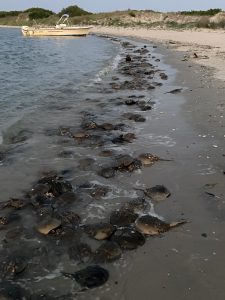By Jack Chavez, Staff Writer

During the late spring and early summer, horseshoe crabs spawn on the coastlines of along Assateague Island and other coastal bay areas. The spawning season is important not only for the species survival but the survival of dozens of other species that depend on the eggs as a vital food source. PHOTO COURTESY MCBP
They’re large, sturdy-looking, spiky and in an ominous shade of brownish-green, but a beachgoer would just as soon be injured in an attack by a rogue beachball than any encounter one might have with a horseshoe crab.
Around the coastal bays region, protecting them is a top priority for environmental organizations such as the Maryland Coastal Bays Program, which just completed a survey in conjunction with the Maryland Department of Natural Resources of these brackish-water arthropods during their spawning season.
“We go out to different sites at Assateague and Skimmer islands and we walk along hundred-meter transects,” said Carly Toulan, an environmental scientist with MCBP. “Along them, we go one meter into the water from the high-tide line and count each horseshoe crab by sex. We do that until we reach the end of the 100-meter transect.”
Toulan added that the survey typically entails two volunteers counting and will use the average if there is a slight disparity in the two counts, but recount if the difference is great.
“In addition to counting and sexing the horseshoe crabs, we count any dead horseshoe crabs along that beach whether, in the transect or not, just to gain an understanding of how many dead are in that area,” she said.
Typically around six volunteers help and Toulan said the half dozen on tap have been helping MCBP for years and thus are familiar with where and how to conduct the survey.
“For this program specifically, the importance (of these volunteers) is being able to cover more ground and survey more areas,” Toulan said. “We wouldn’t be able to get as many survey sites and conduct as many surveys as we do without the volunteers.”
Data from the 2022 survey won’t be available until the fall, but Toulan said so far indications are there won’t be much variance from the 2021 survey.
“The population has been steady, which is really good,” she said. “We haven’t seen any major declines but also we haven’t seen any drastic increase. which is good. We want steady and stable. We’ve been conducting this survey since 2002 in the coastal bays and populations have been steady since. it’s really great and it’s looking like it’ll be consistent this year as well.”
The survey didn’t extend to the very end of the spawning season, which may prompt MCBP to get back out in the surf in July to see just how long the spawning season lasts, Toulan said.
There was also an addition to MCBP’s attention to horseshoe crabs this year with the stranded horseshoe crab recovery team, a group of nearly three dozen volunteers that monitors four different locations for stranded horseshoe crabs that they can safely remove and put back into the water.
While the survey isn’t in need of more volunteers, Toulan said the recovery team is always looking for help.
Protecting horseshoe crabs is vital for three main reasons, Toulan said. First is human health the horseshoe crab’s. Their blue blood can be harvested to create Limulus amebocyte lysate, which is used to test injectable drugs to make sure they’re safe and that no endotoxins are present.
“Any injectable drug or vaccine you’ve had will have been tested with horseshoe crab blood to make sure it’s safe,” Toulan said. “There is a whole biomedical industry revolving around the horseshoe crab.”
Secondly, ecologically speaking, horseshoe crabs are vitally important at this time of year because their eggs are a main source of food for dozens of different fish, birds, mammals and reptiles. For instance, the endangered red knot shorebird stops over in this region on its great migration from South America to the Arctic Circle and depends on the eggs to plump up and store the energy needed to complete their flight, Toulan said.
Thirdly, she added that they’re used as whelk and eel bait, giving them importance to local fisheries.
And, again, as Toulan points out, horseshoe crabs are not dangerous.
“It’s really important that people know that,” she said. “They can’t hurt you. They don’t pinch, sting or bite. (If helping a stranded horseshoe crab) the proper way to hold it is by the sides of its shell. Never pick it up by the tail, which is very sensitive and very fragile. If that tail breaks, it’ll hinder the horseshoe crab’s ability to move and flip over if it gets stuck on its back.”
Anyone who’d like more information on the stranded horseshoe crab recovery team or to volunteer can contact Toulan at ctoulan@mdcoastalbays.org or find more information online at https://mdcoastalbays.org.
This story appears in the print version of the Bayside Gazette on July 7, 2022.
